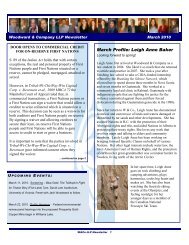Appellants factum - Woodward & Company
Appellants factum - Woodward & Company
Appellants factum - Woodward & Company
Create successful ePaper yourself
Turn your PDF publications into a flip-book with our unique Google optimized e-Paper software.
33completely and finally determined and all multiplicity of legal proceedingsconcerning any of those matters may be avoided. 212C. Alternative Argument: The Trial Judge was not barred from declaringAboriginal title to lesser, included areas in the Claim Area.114. Even if the Plaintiff’s prayer for relief did not include declarations of Aboriginaltitle to lesser, included portions of the Claim Area, the Trial Judge nonetheless had abroad discretion to grant such declarations.His refusal to do so rests on amisunderstanding of the law and reliance on authority that has been roundly rejected asa general statement of the law. Contrary to his conclusions, there was no impedimentto granting declaratory relief shaped by his findings of fact at the conclusion of trial.1. Broad discretion to grant declaratory relief115. The courts’ discretion to grant declaratory relief is not limited to the termsspecifically requested by the plaintiff. A court may grant a declaration upon the factsproven at trial, even if the plaintiff did not request a declaration in those specific terms,or did not request any declaration at all. 213 As part of this discretion, the court maygrant a declaration in narrower terms than those requested. 214116. In Delgamuukw, Mr. Justice Lambert of this Honourable Court, in dissent but noton this point of law, expressed the governing principle as follows:The power to make such declaratory orders is contained in Rule 5(22) of theSupreme Court Rules. And, of course, it is self-evident that if the prayer for reliefasks for a declaration of rights in wider terms than the Court considers justified212 Law and Equity Act, R.S.B.C. 1996, c. 253, s. 10 [underscore added].213 See, e.g.: Native Women's Assn. of Canada v. Canada, [1994] 3 S.C.R. 627, paras. 36-37; Meisner v. Mason,[1931] 2 D.L.R. 156, 1931 CarswellNS 39 (N.S.C.A.); Harrison-Broadley v. Smith, [1964] 1 All E.R. 867 (C.A.); Hulton v.Hulton, [1916] 2 K.B. 642, aff’d [1917] 1 K.B. 813 (C.A.); Rt. Hon. The Lord Woolf & Jeremy Woolf, Zamir & Woolf,The Declaratory Judgment, 3 rd ed. (London: Sweet & Maxwell, 2002), p.283.214 Attorney-General v. Guardians of the Poor of the Merthyr Tydfil Union, [1900] 1 Ch. 516 (C.A.), pp. 550-551; ReLewis’s Declaration of Trust; Lewis v. Lewis; Lewis v. Ryder, [1953] 1 All E.R. 1005, (sub nom. Loudon v. Ryder (No.2)), [1953] 1 All E.R. 1005, [1953] Ch. 423 (Ch. D.); Nicholls v. Tavistock Urban District Council [1923] 2 Ch. 18(Ch.D.); R v. Bales; Ex parte Meaford General Hospital (1970), [1971] 2 O.R. 305, 17 D.L.R. (3d) 641 (Ont. H.C.); Rt.Hon. The Lord Woolf & Jeremy Woolf, Zamir & Woolf, The Declaratory Judgment, 3 rd ed. (London: Sweet &Maxwell, 2002) at 284; Frederick M. Irvine, McLachlin & Taylor, British Columbia Practice, 3rd ed., looseleaf(Markham: LexisNexis, 2005), at 5-66.



